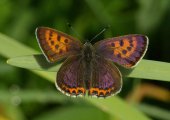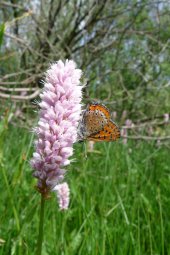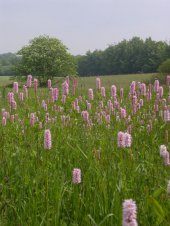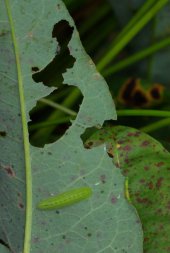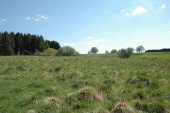Violet copper butterfly (Lycaena helle)
Scientific name: Lycaena helle
Protection status: Red List Germany: 1
Red List NRW: 1S
FFH Annexes II and IV
Distribution: The total distributional range extends from western Europe to eastern Asia. In Germany the occurrence of the species is restricted to just six regions, including some upland areas and the foothills of the Alps.
Habitat: The violet copper lives in flower-rich damp meadows where bistort (Polygonum bistorta) is found, under cool-moist climatic conditions.
Peculiarities: It has only recently been observed that individuals of this butterfly will apparently fly onto copses to spend the night there.
A European symbol of species-rich upland valleys
Germany can count itself lucky to carry a special European responsibility for the violet copper butterfly (Lycaena helle). The occurrence of this FFH species indicates unspoiled and functioning alluvial ecosystems in intact upland landscapes. It only lives where clean streams flow through flower-rich damp meadows. The northern Eifel is one of only six regions in the country that have the necessary qualities. Along with an extensive method of land utilization, climate and soil are also important factors. The species’s ecological requirements are best fulfilled by cool-moist conditions on slightly acidic nutrient-poor soils. Therefore during the recolonization of Central Europe following the last glaciation the violet copper was able to permanently settle only in upland areas as well as the foothills of the Alps.
A decisive factor in the distribution of the species is the presence of bistort (Polygonum istorta), a perennial plant up to 1.2 m in height which, with its pink-coloured flowerheads, forms quite conspicuous and extensive stands. In Central Europe the caterpillars of the violet copper feed exclusively on the leaves of this plant. The adult butterfly will feed on many other flowering plants but prefers taking up the nectar of the bistort.
Appearance
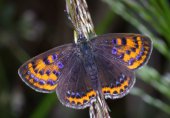
Female violet copper butterfly
Given its small wingspan of 2.5-3 cm and the overall dark coloration of the upperside of its wings, the violet copper is at first rather inconspicuous. But on moving closer and differentiating small details it soon becomes clear how the butterfly’s name is derived. Several of the specially structured scales on the wings refract the sunlight in such a way that mainly the blue element is reflected. The upperside of the wings then appear bluish-violet and iridescent, shimmering with each change of angle the insect makes with every movement. The intensity of this colouring differs between the sexes; while the upperside of the male’s wing surface is completely iridescent blue, this is confined in the female to small areas.
Life cycle
The life cycle of the butterfly follows the typical pattern of highly developed insects. A larva or caterpillar hatches from an egg in July, which then over the next two to three weeks develops into a stationary stage or pupa, also chrysalis. The pupal resting time starts at the end of July/beginning of August, and ends with the emergence of the adult butterfly, or imago, from May until the end of June. At this time the fertilized females lay their eggs singly on the leaves of the bistort plant.
Nature conservation measures and actions
Botanical censusing of the present situation in the wet fallow grassland along the Kall and its tributaries have shown a gradual change in the vegetation. The cause is thought to be a rise in the nutrient supply. This can come from the agricultural lands adjacent to the fallows, via input from the atmosphere, or can arise within the area itself due to the accumulation of plant litter.
One way of countering this undesirable fertilization and resulting change in the vegetation is the annual mowing of the area. Nutrients are then withdrawn from the vegetation by removing the resulting litter. However, this action must be coordinated with the life cycle of the violet copper. To protect the sensitive larval stage the mowing is carried out in late summer at the earliest, when the pupal stage has been reached. But since the pupae are attached to the bistort leaves they too will finish up in the litter and so there is a danger that they will also be removed from the area. To prevent this only part of the vegetation is mown each year, thereby ensuring that at least a good proportion of the butterfly population survives.
Monitoring
The success of these measures will be overseen by the “Rur and Kall” team within the framework of a monitoring programme. This will entail the mapping of all changes in the composition of the vegetation as well as the distribution of the butterflies and caterpillars in their habitat. These observations are indispensable to the permanent protection of the violet copper population.
Web Links
Weiterführende Literatur
AGNES, G. (2000): Schmetterlingszönosen in der Deutsch-Belgischen Hocheifel und Untersuchungen zur Eignung von Indikatorarten für die Differenzierung vernäßter Standorte. Dipl.-Arbeit, Bonn
ARNSCHEID, W. (1978): Lycaena helle in Westfalen. Mitteilungen westf. Entom. 2 S.21-22
Bachelard, P.; Descimon, H. (1999): Lycaena helle (Denis & Schiffermueller, 1775) in the Central Massif (France): an ecogeographical analysis (Lepidoptera: Lycaenidae) Linneana Belgica 17, S.23-41
BAUERFEIND, S. S., THEISEN, A. & K. FISCHER (2009): Patch occupancy in the endangered butterfly Lycaena helle in a fragmented landscape: effects of habitat quality, patch size and isolation. – Journal of Insect Conservation 13: 271-277.
BERNARDI, G. & DE LESSE, H. (1952): La variabilite geographique de Lycaena helle Revue Franc. Lepidopt. 13-14, S.203-214
BIEWALD, G. & NUNNER, A. (2006): Lycaena helle. – In: PETERSEN, B. & ELLWANGER, G. (Hrsg.): Das europäische Schutzgebietssystem Natura 2000. Ökologie und Verbreitung von Arten der FFH-Richtlinie in Deutschland, Band 3: Arten der EU-Osterweiterung. – Schriftenreihe für Landschaftspflege und Naturschutz, Bonn – Bad Godesberg (Landwirtschaftsverlag GmbH), 69/3: 139-153.
BÜCK, M. (1996): Vegetationskundliche und strukturelle Charakterisierung der Habitate typischer Tagfalter im Feuchtgrünland der Westeifel. Dipl.-Arbeit, Bonn
DERENNE, F. (1939): Heodes amphidamas en Belgique et dans les Ardennes francaises. Lambillionea 39, S. 161-165
DONNER, A. (2004): Metapopulationsdynamik des Blauschillernden Feuerfalters Lycaena helle im Hohen Westerwald. Diplomarbeit, Bayreuth.
DREWS M. & FECHNER S. (1996): Beziehungen zwischen der Vegetation und den Tagfaltern Blauschillernder Feuerfalter (Lycaena helle) und Randring-Perlmuttfalter (Proclossiana eunomia) im Nonnenbachtal bei Blankenheim (Eifel). Dipl.-Arbeit, Bonn
FALKENHAHN H.J. (2005): Artensteckbrief Blauschillernder Feuerfalter (Lycaena helle) in Hessen.
FASEL, P. (1982): Beitrag zur Schmetterlingsfauna des Hohen Westerwaldes im Gebiet von Rabenscheid. Hessische faunistische Briefe 2, S.30-36
FINGER A. et al (2009): The genetic status of the violet copper Lycaena helle. Ecography 32, S.382-390
FISCHER, K. (1996): Populationsstruktur, Mobilität und Habitatpräferenzen des Blauschillernden Feuerfalters L. h. in Westdeutschland. Diplomarbeit, Uni Marburg.
FISCHER, K. (1998): Zu Fekundität, Fertilität und Präimaginalbiologie des Blauschillernden Feuerfalters Lycaena helle (Lepidoptera: Lycaenidae). – Verh. Westd. Entom. Tag 1997: 167-176.
FISCHER, K., BEINLICH, B. & PLACHTER, H. (1999): Population structure, mobility and habitat preferences of the Violet Copper Lycaena helle (Lepidoptera: Lycaenidae) – implications for conservation. – Journal of Insect Conservation 3: 43-52.
FISCHER, U. & FIEDLER, G. (2000): Methodische Aspekte von Fang-Wiederfangstudien am Beispiel der Feuerfalter Lycaena helle und L. hippothoe. Beitr. Ökol. 4(2), S.157-172
GASSE, C. (2000): Neufund des Blauschillernden Feuerfalters Lycaena helle im Hochsauerlandkreis. Melanargia, 1, 12-14
GOFFART, P., SCHTICKZELLE, N. & TURLURE, C. (2010): Conservation and management of the habitats of two relict butterflies in the Belgian Ardenne: Proclossiana eunomia and Lycaena helle. – In: HABEL, J. C. & ASSMANN, T. (Hrsg.): Relict species: Phylogeography and conservation biology, Berlin, Heidelberg (Springer): 357-369.
GOLTZ, C. (1978): Die Zucht von Lycaena helle. Mitteilungen der Arbeitsgemeinschaft rheinisch-westfälischer Lepidopterologen, 1, S.65-66
HABEL, J. C., AUGENSTEIN, B., MEYER, M., NÈVE, G., RÖDDER, D. & ASSMANN, T. (2010): Population genetics and ecological niche modelling reveal high fragmentation and potential future extinction of the endangered relict butterfly Lycaena helle. – In: HABEL, J. C. & ASSMANN, T. (Hrsg.): Relict species: Phylogeography and conservation biology, Berlin, Heidelberg (Springer): 417-439.
HABEL J.C., RÖDDER D., SCHMITT T., NEVE G. (2011): Global warming will affect the genetic diversity and uniqueness of Lycaena helle populations. Global Change Biology 17, S.194-205
HABEL J.C., FINGER A., MEYER M., Schmitt T., ASSMANN T. (2008) Polymorphic microsatellite loci in the endangered butterfly Lycaena helle (Lepidoptera: Lycaenidae). Journal of European Entomology 105: 361-362
HABEL J.C., FINGER A., SCHMITT T., NEVE G. (2011) Changing over time: 15 years of isolation influence the population genetic structure of the endangered butterfly Lycaena helle. Journal of Zoological Systematics and Evolutionary Research 49: 25-31.
HABEL J.C., SCHMITT T., MEYER M., FINGER A., RÖDDER D., ASSMANN T., ZACHOS F.E. (2010): Biogeography meets conservation biology: genetic structures of the highly endangered postglacial relict butterfly Lycaena helle. Biological Journal of the Linnean Society 101: 155-168.
HACKRAY, J. (1945): A propos l’existence de Lycaena amphidamas f. obscura Rühl dans les Hautes Fagnes. Lambillionea 45, S.13-15
HACKRAY, J. (1945): A propos l’existence de Lycaena amphidamas f. obscura Rühl dans les Hautes Fagnes. Lambillionea 45, S.22-24
HANNEMANN, J. (1928): Etwas über Chrysophanus amphidamas. Internationale entomologische Zeitschrift 22, S.209-210
HASSELBACH, W. (1985): Lycaena helle – Die Zucht einer in der BRD vom Aussterben bedrohten Art. Ent. Z. Frankfurt am Main, 95, 70-76
HENNICKE, M. (1996): Entdeckung eines Vorkommens von Lycaena helle in Mecklenburg-Vorpommern. Entomologische Nachrichten Brandenburg 40, 2. S.129-130.
HENSEL, W. (1928): Chrysophanus amphidamas. Internationale entomologische Zeitschrift 22, S.237
KINKLER, H. (1979): Die Schmetterlinge des Nonnenbachtales bei Blankenheim/Eifel. Mitteilungen der Arbeitsgemeinschaft rheinisch-westfälischer Lepidopterologen 2, S.9-13
KRETSCHMER H. (2008): Zum ehemaligen Vorkommen und zu Möglichkeiten der Wiederansiedlung des Blauschillernden Feuerfalters Lycaena helle (Denis & Schiffermüller, 1775) in Brandenburg (Lepidoptera, Lycaenidae). Märkische Ent. Nachr. 10, S.117-124
LUTHER S. (2011): Untersuchungen zu Habitatpräferenzen des Blauschillernden Feuerfalters (Lycaena helle) und des Randring- Perlmutterfalters (Boloria eunomia). Masterarbeit, RWTH Aachen.
MEYER, M. (1980): Die Verbreitung von Lycaena helle in der BRD Ent. Z. Franfurt am Main, 90, 217-224
MEYER, M. (1980): Une sous-espece meconnue de Lycaena helle. Linneana Belgica 8, S.130-139
MEYER, M. (1982): Revision systematique, chorologique et ecologique de Lycaena helle. Linneana Belgica, 8, S.238-260
MEYER, M. (1982): Revision systematique, chorologique et ecologique de Lycaena helle. Linneana Belgica 8, S.345-358
MEYER, M. (1982): Revision systematique, chorologique et ecologique de Lycaena helle. Linneana Belgica 8, S.451-466
MEYER, M. (1982): Les races europeennes de Lycaena helle et leurs biotopes. Proceedings 3rd Congr. Eur. Lepid. Cambridge 1982, Karlsruhe 1985, S.125-137
MEYER, M. & HELMINGER, T. (1994): Untersuchungen zu einer Population von Lycaena helle arduinnae MEYER, 1980 im nordwestlichen Ösling. Bull. Soc. Nat. luxemb. 95, S.315-326
NIPPEL, F. (1993): Ein weiterer Fund von Lycaena helle in der Eifel. Melanargia 5, S.47
MEYER, M. & HELMINGER, T. (1994): Untersuchungen zu einer Population von Lycaena helle arduinnae Meyer, 1980 im nordwestlichen Ösling (Lepidoptera, Lycaenidae) Bull. Soc. Nat. Luxemb. 95: 315-326
NUNNER, A. (1995): Zur Autökologie von Boloria eunomia (Esper 1799) und Lycaena helle ([Denis & Schiffermüller] 1775) (Lepidoptera: Rhopalocera) im bayerischen Alpenvorland. – Universität Tübingen (Diplomarbeit): 157 S.
NUNNER, A. (2006): Zur Verbreitung, Bestandssituation und Habitatanbindung des Blauschillernden Feuerfalters (Lycaena helle) in Bayern. – In: FARTMANN, T. & HERMANN, G. (Hrsg.) (2006): Larvalökologie von Tagfaltern und Widderchen in Mitteleuropa. – Abhandlung aus dem Westfälischen Museum für Naturkunde 68 (3/4): 153-170.
NUNNER, A. (in Vorb.): Der Blauschillernde Feuerfalter, Lycaena helle. – In: Die Tagfalter Bayerns.
NUNNER, A. & WALTER, R. (1999): Einsatz der standardisierten Populationsprognose (SPP) für die Naturschutzplanung in fragmentierten Torfstichgebieten Südbayerns. – In: AMLER, K., BAHL, A., HENLE, K., KAULE, G., POSCHLOD, P. & SETTELE, J. (Hrsg.): Populationsbiologie in der Naturschutzpraxis. Isolation, Flächenbedarf und Biotopansprüche von Pflanzen und Tieren, Stuttgart (Ulmer): 214-224.
REAL, P. (1962): Les Pyrenees Orientales, refuge entomologique. Ann. Sci. Univ. Besancon, 2. Ser. Zool. 17, S.97-110
REAL, P. (1962): Les stations de Lycaena helle D. et Schiff. Dans le Doubs. Note de faunistique jurassienne no 1 Ann. Sci. Univ. Besancon, 2. Ser. Zool. 17, S. 111-118
REAL, P. (1962): Quelque remarques aur Lycaena helle D. et Schiff. Dans les Monts de la Madelaine. Ann. Sci. Univ. Besancon, 2. Ser. Zool. 17, S.119-120
REAL, P. (1962): Lycaena helle D. et Schiff. (ex Heodes amphidamas Esp.) dans le Massif de Sancy. Ann. Sci. Univ. Besancon, 2. Ser. Zool. 17, S.121-134
REAL, P. (1962): Point actuel des connaissances sur la repartion geographique de Lycaena helle D. et Schiff. En France. Ann. Sci. Univ. Besancon, 2. Ser. Zool. 17, S.135-138
REAL, P. (1962): Quelques considerations sur le repartition geographique de Lycaena helle D. et Schiff. En Europe. Ann. Sci. Univ. Besancon, 2. Ser. Zool. 17, S.139-144
SCHILLER, R. (2007): Lycaena helle ([Denis & Schiffermüller], 1775) Blauschillernder Feuerfalter. – In: KLAUSNITZER, B. & REINHARDT, R. (Hrsg.) Beiträge zur Insektenfauna Sachsens. Band 6: REINHARDT, R., SBIESCHNE, H., SETTELE, J., FISCHER, U. & FIEDLER, G.: Tagfalter von Sachsen. – Entomologische Nachrichten und Berichte, Beiheft 11: 211–213.
SCHMIDT K. & PAULUS H. (1970): Die Feinstruktur der Flügelschuppen einiger Lycaeniden (Insecta, Lepidoptera). Zoomorphology 66, 3, S.224-241
SCHÖNING, R. (1971): Über ein Vorkommen von Lycaena helle im Dillkreis/Hessen (Lep., Lycaenidae) Entomologische Zeitschrift 81, S.174-175
SCHUBERT, E. (2008): Habitatnutzung des Blauschillernden Feuerfalters (Lycaena helle) bei Ueckermünde. – Universität Greifswald (Diplomarbeit): 76 S.
STEINER, R. TRAUTNER, J & GRANDCHAMP, A. C. (2006): Larvalhabitate des Blauschillernden Feuerfalters (Lycaena helle) am schweizerischen Alpennordrand unter Berücksichtigung des Einflusses von Beweidung. – In: FARTMANN, T. & HERMANN, G. (Hrsg.): Larvalökologie von Tagfaltern und Widderchen in Mitteleuropa. – Abhandlung aus dem Westfälischen Museum für Naturkunde 68 (3/4): 135-151.
THEIßEN B. (2003): Die Tagfalterfauna des NSG Perlenbach-/Fuhrtsbachtal im Jahre 2001 und ihre Entwicklung innerhalb der letzten zehn Jahre. Melanargia 15(1), 17-30.
WACHLIN, V. (2009): Lycaena helle (Denis & Schiffermüller 1775). Steckbrief FFH-Arten: Lycaena helle. – Greifswald (Institut für Landschaftsökologie und Naturschutz): 7 S.
WEISS, J.C. (1977): Lycaena helle Schiff. et Proclossiana eunomia Esper. Dans les Vosges. Description d’une nouvelle sous-espece de Lycaena helle Schiff. Linneana Belgica 6, S.253-256
WIPKING, W., FINGER, A. & MEYER, M. (2007): Habitatbindung und Bestandssituation des Blauschillernden Feuerfalters Lycaena helle (Denis & Schiffermüller) in Luxemburg (Lepidoptera, Lycaenidae). – Bull. Soc. Nat. luxemb.: 108: 81-87.



